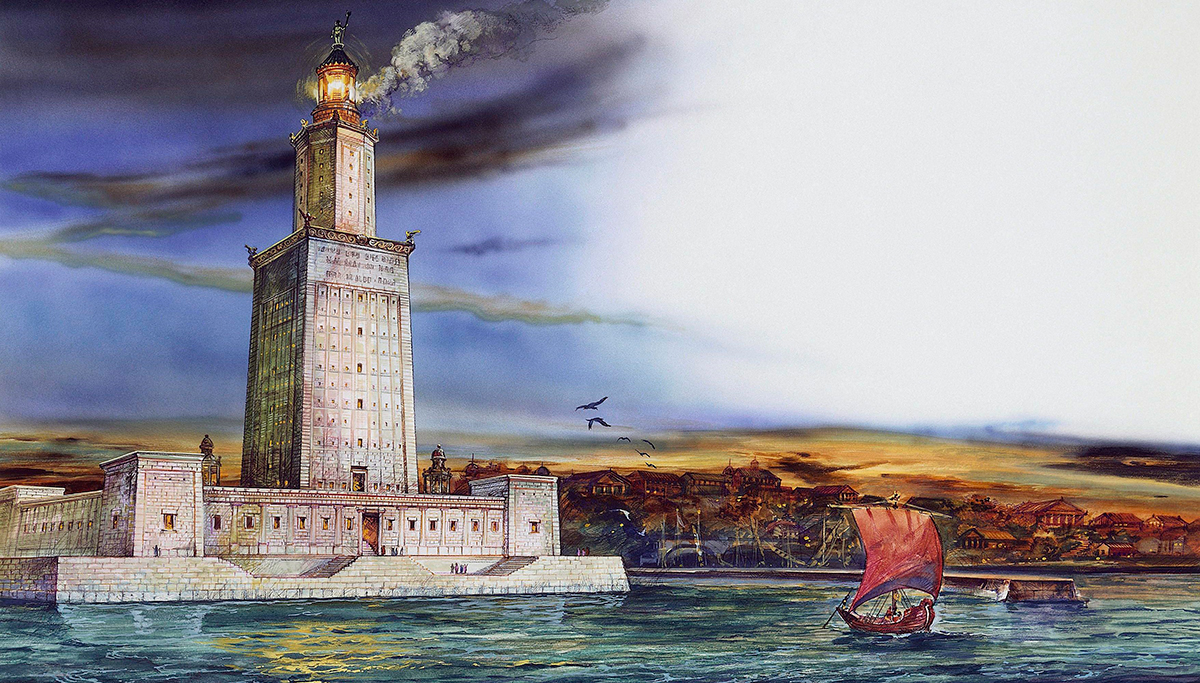
To create clearly defined harbours, navigators were guided by fires on hilltops. This was often a temple with a fire that could be seen far out from sea. Because there was not always a high point in the landscape, artificial elevations were built in the form of lighthouses. This article, based largely on a report by Ken Trethewey1, looks at the extent to which there is evidence of the presence of lighthouses in Roman ports after the construction of the famous Pharos of Alexandria.
The lighthouse was not an invention of the Romans. However, it was the Romans who adopted the basic principle of the lighthouse from Hellenistic culture and covered it with the template of the Alexandrian lighthouse. The resulting design was included as part of the overall layout in the construction of port facilities. We can therefore without doubt attribute the modern use of lighthouses to the Romans.
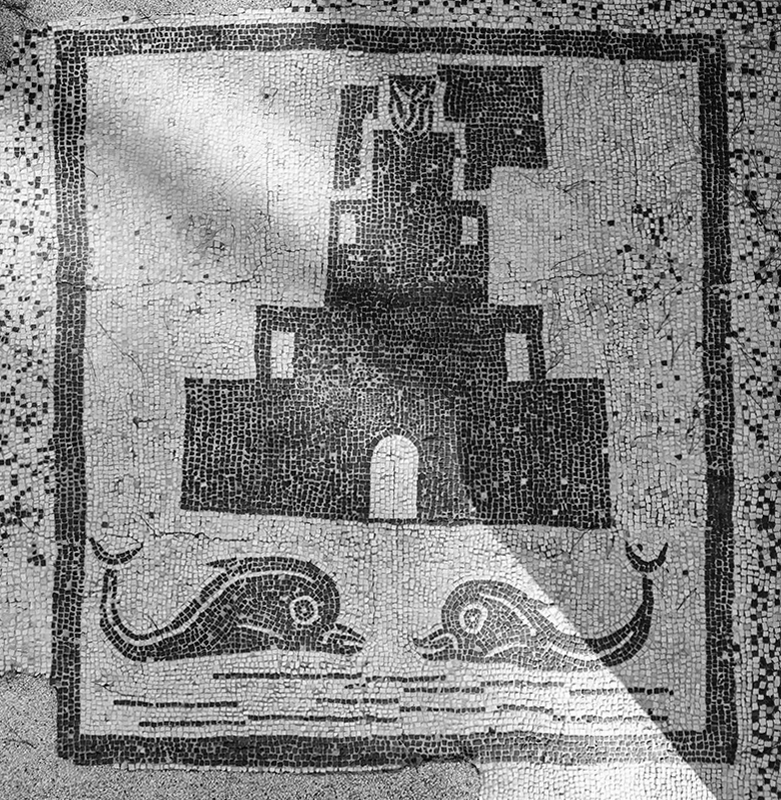
the lighthouse of Portus
Although there must have been many lighthouses and other beacons at the large number of ports built by the Romans, tangible evidence for this is very scarce. We are of course familiar with the various images on coins, mosaics, reliefs and painted decorations, from which we can deduce how deeply ingrained the lighthouse was in the Roman psyche. You can actually expect that there was a lighthouse in every port where the Romans traded.
The Romans were by nature not a shipping people. The great expansions of the Roman Empire came about with the help of a land army, a military fleet was built late. Although people saw the benefits of transport over water, they were still fearful of the dangers of the sea and of "bad luck".
Lionel Casson2 describes sea voyages across the Mediterranean at the beginning of our era as follows: Usually 3 ships were sent out with a non-Roman crew. The ships were propelled by a combination of sails and rowers, usually consisting of freedmen (slaves could not be relied upon in severe weather or difficulties). Cargo ships were large and mainly relied on sails, with fewer rowers and a small number of soldiers for self-defense.
Due to the relatively late rise of shipping and the ports required for it, it seems that the first Roman lighthouses were built at the time of Augustus or Caligula, around the beginning of our era at locations such as Puteoli or Capreae, the current Capri or Ostia.
How did a lighthouse work?
There is little information in the literature from that time, but for the fire in a lighthouse is believed they used locally fuel, such as wood or coal. Lighthouse keepers may have added flammable liquids to reduce fuel costs and to keep the light stable during storms. It is also possible that the light was protected from the wind by glass windows and that large mirrors helped project the firelight as far as possible. It could hardly be otherwise that it took a lot of work to transport the fuel and maintain the flame.
Various ports of which we know something about the lighthouse.
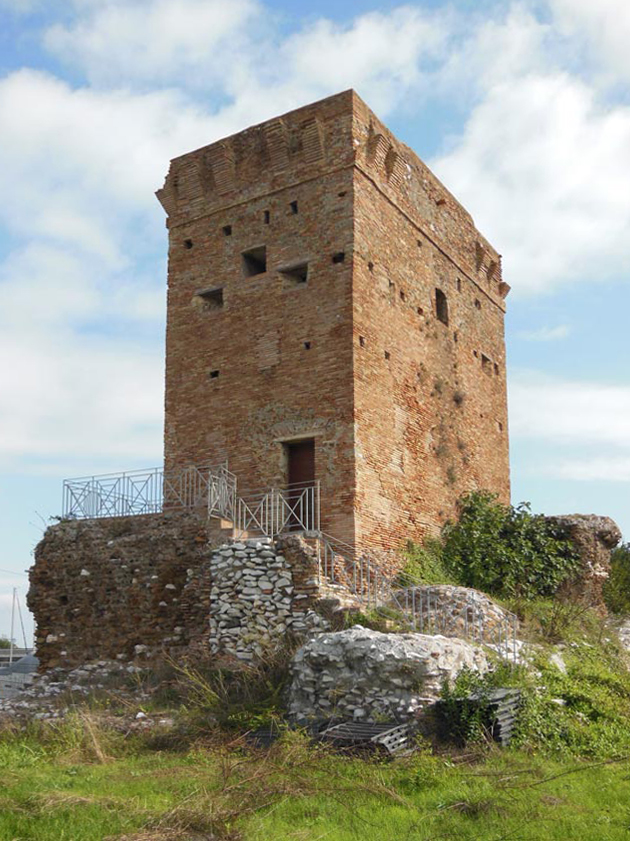
PORTUS ROMANUS (Ostia)
The most important port, of course, was that of Ostia, the literary heart that pumped life between the capital and its branches.
Actually we should speak here about three ports, the port of Ostia, the port of Claudius in Portus and the port of Trajan in Portus.
The oldest, the port of Ostia, was located at the mouth of the Tiber3. The port facilities were located on both banks of the river. At the location where you might expect a lighthouse (see figure 4) you'll find a tower indeed, Tor Boacciana, built on the foundation of what must have been certainly a Roman tower4. A sailor only had to sail up the Tiber with the tower on his starboard side for entering the harbour on the right-hand side.
The geometry of the current tower shows that the original lighthouse, which certainly stood here, was not in the shape of the Alexandrian tower. That raises the question about the construction date. This must have been somewhere between 280 BC. and 42 AD; from the time lighthouses were built until the time when Claudius lighthouse was widely seen as the pattern for new lighthouses to be built in the empire. This could therefore mean that this was the first Roman lighthouse.
PORTUS ROMANUS (The port of Claudius)
“Portum Ostiae exstruxit circumducto dextra sinistraquw brachio et ad introitum profundo iam solo mole obiecta; quam quo stabilius fundaret, navem ante demersit, qua magnus obeliscus ex Aegypto fuerat advectus, congestisque pilis superposuit altissimam turrem in exemplum Alexandrini Phari, ut ad nocturnos ignes cursum navigia dirigerent.” 6
In this way the Roman historian Suetonius described how the Emperor Claudius started the construction of the harbour of Portus in 42 AD7.
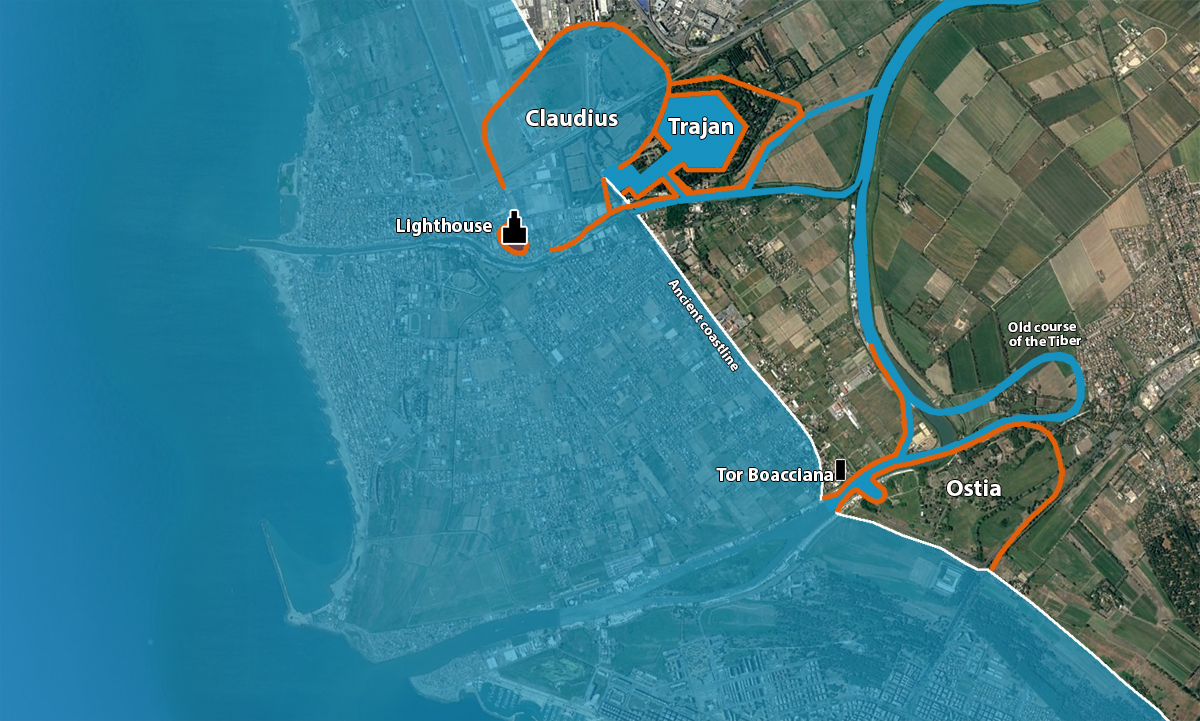
Where the port of Ostia was about 2 hectares, the new port of Claudius amounted to more than 200 hectares and offered moorings for several kilometers. The most striking thing about this harbour was that it was built in the sea, protected by two artificial moles with an island in between on which a lighthouse was built8. The moles were built of enormous blocks of 6 to 7 tons of the same kind of limestone (travertine) with which the Alexandria lighthouse was built.
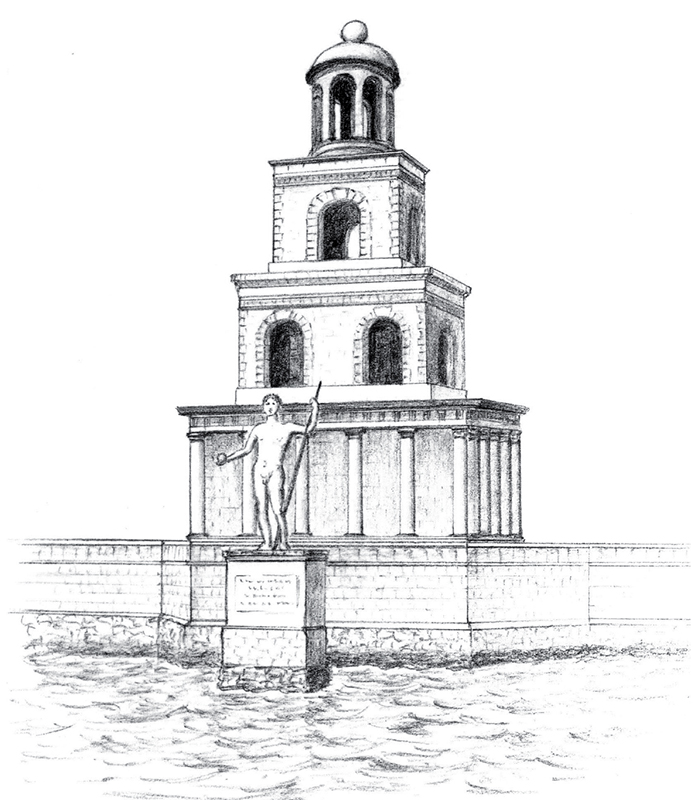
The artificial lighthouse island of which Suetonius spoke was built on a sunken ship that had previously carried an obelisk to Rome9.
There is no doubt about the existence of this lighthouse as many descriptions and images have been preserved, including the various mosaics on the Piazzale delle Corporazioni in Ostia (see figure 2). The location of the tower has also been clarified for some years now. Recent archaeological research by the Portus project led by Simon Keay has, by means of soil drilling, carried out by geo-archaeologist Antonia Arnoldus Huyzendveld, managed to trace the exact location. The foundation of the tower is buried under a junkyard in the middle of Fiumicino North.
Images of the lighthouse show a number of quadrangular sections (usually 4) surmounted by a cylindrical top in which the fire burned.
PORTUS ROMANUS (Trajan)
In 103 AD. the harbour was expanded by Trajan. He built a hexagonal basin behind the harbour of Claudius. The new hexagonal harbour was called Portus Traiani or Portus Traiani Felicis. The two ports together were called Portus Augusti et Traiani Felicis or simply Portus Uterque (both ports). Some later depictions of the harbours show some other towers, both at the ends of the moles and in the middle of the harbour. Although there is no evidence for this, it has been suggested that these served to indicate the link between the Claudius basin and that of Trajan, which does not seem illogical for such a complex port of this size11.
CENTUMCELLAE (Civitavecchia)
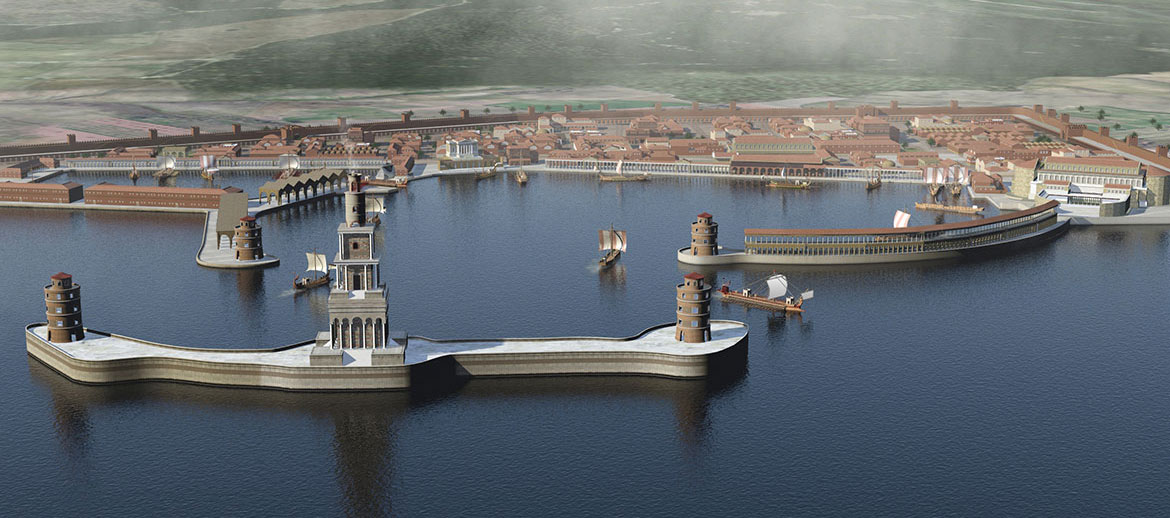
The oldest source we have of Centumcellae comes from a letter from Pliny from 107 AD. where, as a guest in Trajan's palace, he tells how he sees the new harbor being built12. It is believed that this construction began at the beginning of the year 106 AD. For a long time the port of Centumcellae served as the second port of Rome.
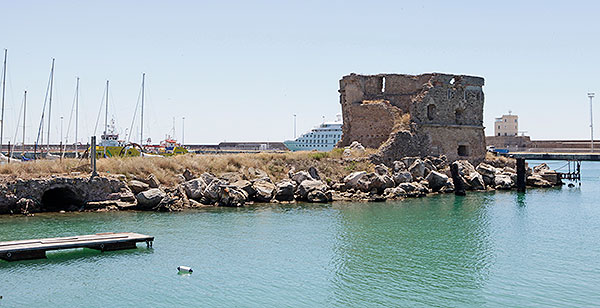
The large harbour basin was formed by two moles and a breakwater. As in the Portus Romanus, a darsena, an inner basin, was also built here.
Pliny did not describe the construction of a lighthouse. Perhaps because it was only added later. Some scientists believe that this harbour was a copy of the harbour of Claudius and that the lighthouse was in the center of the breakwater, just like in Portus. However, in old illustrations (figure 8) we see a total of four towers. One at the ends of each mole and the same for the breakwater. We can clearly see that the south tower on the breakwater is higher than the other three. Presumably that was the lighthouse.
By the way, the tower on the north mole, called Lazzaretto tower, is generally seen by others as the antique lighthouse. This is the only tower where some of it has been preserved. We actually cannot say with certainty which tower was the real lighthouse because the breakwater as well as the south mole have disappeared under later constructions.
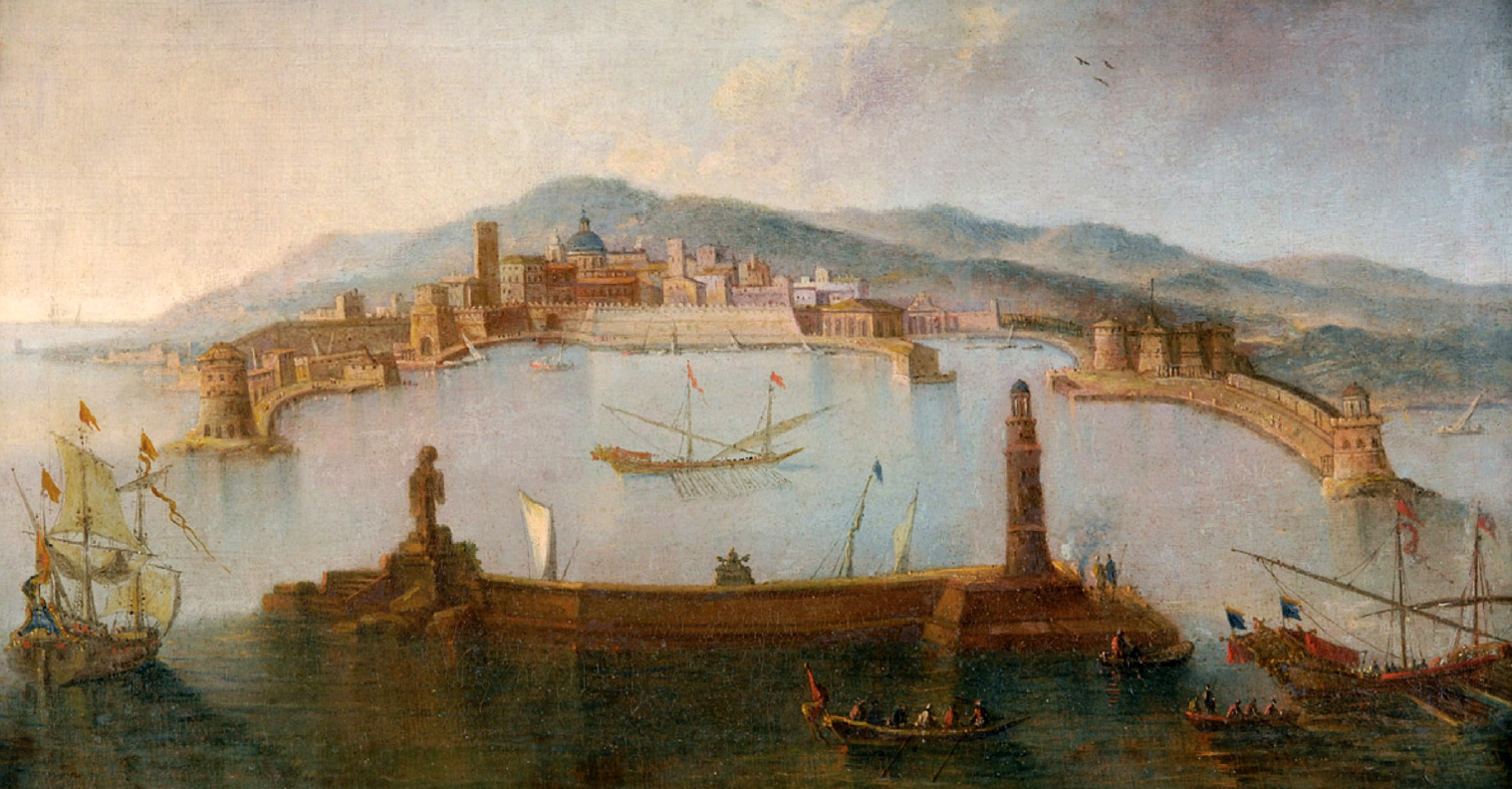
TARRACINA
At the port of Tarracina, built by Trajan, stood the temple of Iuppiter Anxur13 high on a hill. A fire was probably lit in the upper part of the temple to guide navigators. Since only the lower parts of that temple have survived today, we have no certainty about it14.
But there would be some indications that there was indeed a lighthouse in Tarracina. If so, it would certainly have resembled that of Portus Claudius. The 19th century architect Luigi Canina has already drawn the lighthouse on an artist impression of the harbour that now hangs in the Museo Civico of Terracina.
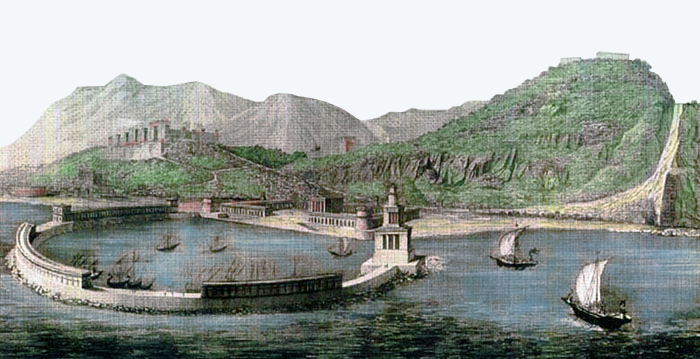
PUTEOLI15
One of the greatest technological discoveries in construction engineering was made here by accident. Material found in the Bay of Naples, and especially in Puteoli, was, mixed with calcareous substances, found to be extremely suitable for processing into cement for maritime applications. The material was called pozzolan, after the location Puteoli 16.
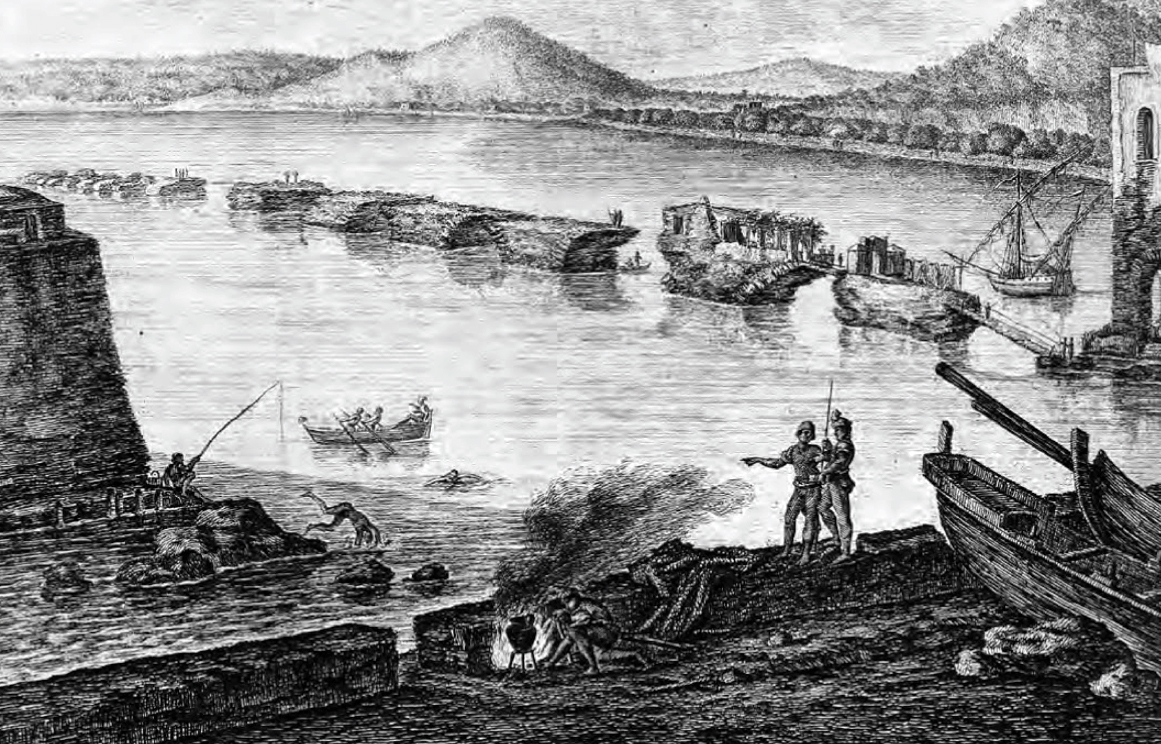
At the beginning of our era a pier was built in Puteoli with a length of 372 meters and a width of 16 meters. The pier consisted of pilae (columns) supporting a concrete walkway. The columns were used in the 20th century as the basis for a modern pier, losing tangible evidence of the antique pier including some evidence of a lighthouse. Fortunately, we still have written references from ancient times to a lighthouse at the end of that pier.
The lighthouse may have been toppled by an earthquake and dragged into deeper water by two ships moored to it. This interpretation is prompted by the recent discovery of the two sunken ships in the deeper waters of the bay.
MISENUM 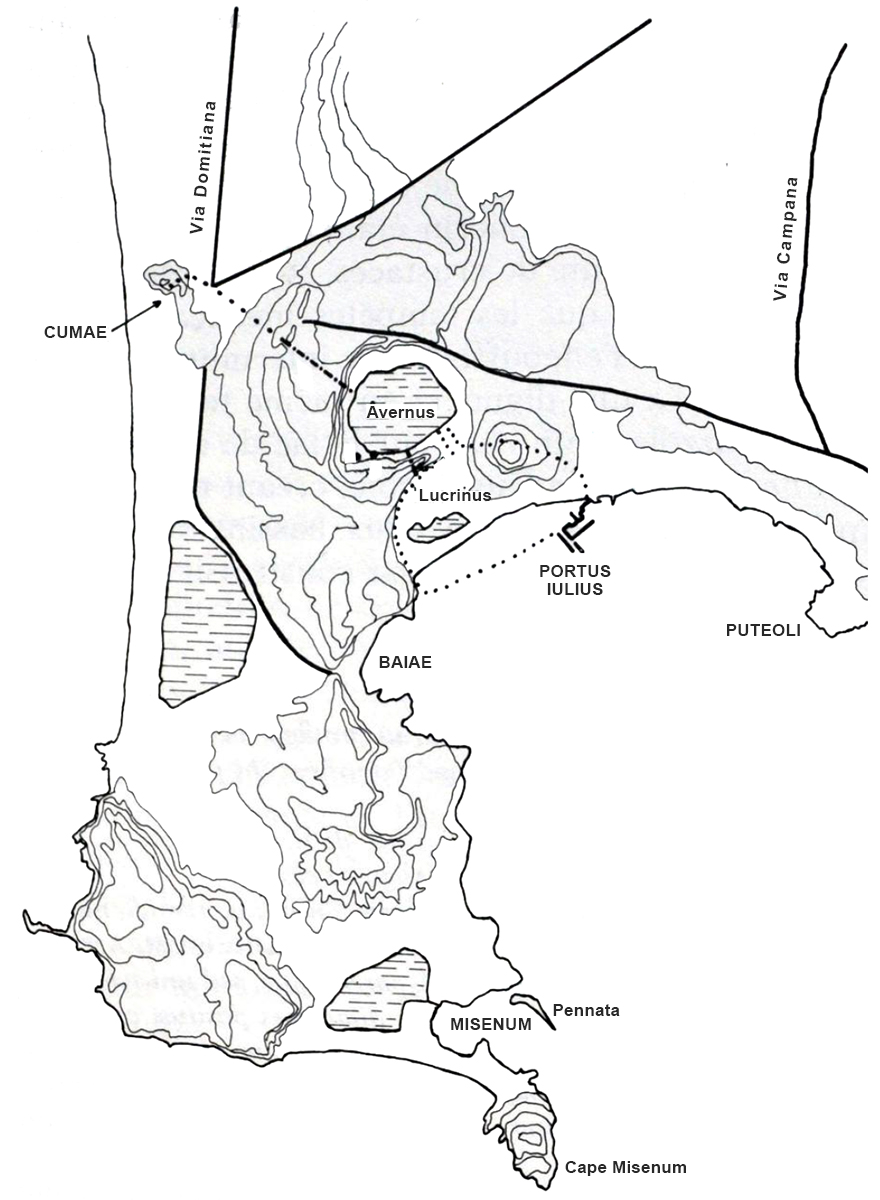 Portus Baianus and Portus Iulius both had moles and harbour facilities that are now underwater. This can still be recognized from the air (or via Google Earth). Although history suggests a tradition of lighthouses at the ends of moles, there is no evidence that this is true. Perhaps they weren't there because lighthouses could also betray the presence of the military naval units lying there.
Portus Baianus and Portus Iulius both had moles and harbour facilities that are now underwater. This can still be recognized from the air (or via Google Earth). Although history suggests a tradition of lighthouses at the ends of moles, there is no evidence that this is true. Perhaps they weren't there because lighthouses could also betray the presence of the military naval units lying there.
According to Giardina18, the entrance to the port of Misenum was marked with a light and also opposite that location, at the tip of the island of Pennata, was a beacon of light. Both places are now under water. However, archaeological evidence for this is lacking.
In addition to the great difficulties that had to be overcome in any case when building a harbour, in the case of a lighthouse at Cape Misenum, the site was also very difficult to reach. Therefore, a lighthouse at that location did not seem obvious. A lighthouse would have needed watchmen and a constant supply of provisions and fuel.
However, it seems that a solution was found after all. In 1951 the archaeologist Amedeo Maiuri found the remains of a large structure that, as he believed, belonged to a lighthouse or a specola (observatory). Perhaps the building served both purposes. Subsequent measurements showed that the distance from a possible lighthouse on Cape Misenum to a sister tower in the Villa Jovis on Capri measured 30 km and a clear, unobstructed view was possible from both. On the other hand, it would also have been strange if there haven't been a lighthouse on the cape. Ships heading north to Ostia had to pass the lighthouse on the starboard side. For the Bay of Naples, Misenum, Portus Iulius or Puteoli, just on the port side. It is therefore difficult to imagine that at that time, with such a busy trade route and so many moorings for the Roman fleet, there would have been no navigational beacon.
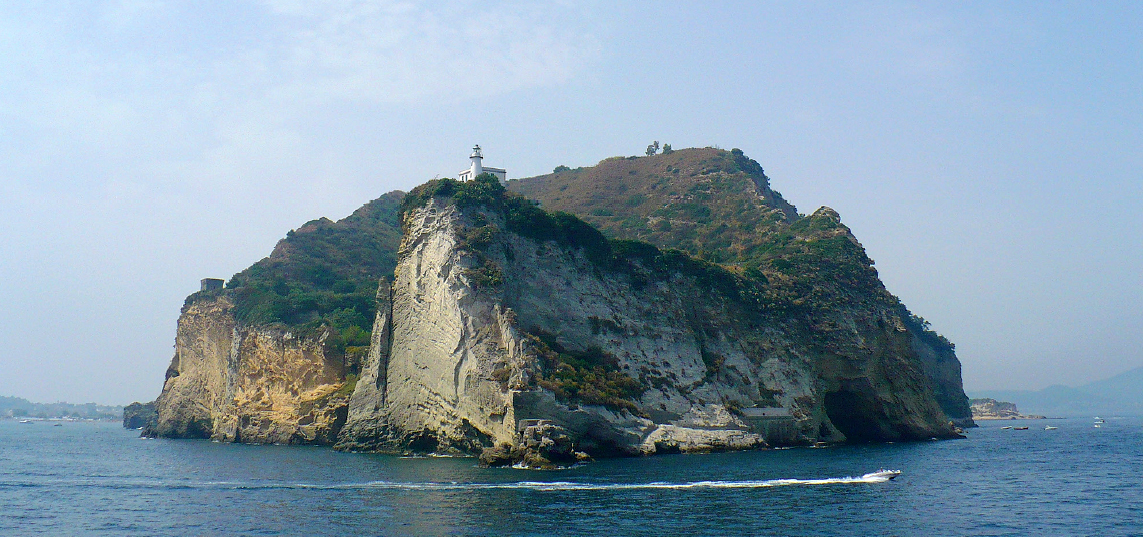
CAPREAE (Capri)
The Island of Capreae is 28 km away from Cape Misenum. Originally the island was Greek but after the battle of Actium in 31 BC. Octavian arrived on the island and found it so attractive that he exchanged it for the Roman island of Ischia. Octavian, who later became known as Augustus, used the island as a holiday destination and built many villas including the Villa Jovis and the Villa Damecuta. After his death, the island was the residence of his successor Tiberius for 10 years (27 - 37 AD).
The remains of a dilapidated tower have been found in the floor of the Villa Jovis, which clearly proves that on Capri, some 100 meters from the main chambers of the palace, there was a lighthouse known as Villa Jovis (Low). We are dealing here with a new kind of lighthouse. The lighthouses mentioned so far were used to mark the entrance to a harbour, in this case it was more a navigation beacon. Unfortunately the light from the lighthouse could not be seen all 360 degrees around the island20.
Suetonius21 wrote a few days before Tiberius' death that the Capri lighthouse had been destroyed by an earthquake. Clearly, not in its entirety as can be seen from the remains. Perhaps they had already recognized the limited visibility of the tower and decided to build a new tower at a higher and safer place on the island. This tower is known as Villa Jovis (High). According to Krause, it was 60 meters high and its light shone over a great distance in the Bay of Naples and over all other seas to the north and south.
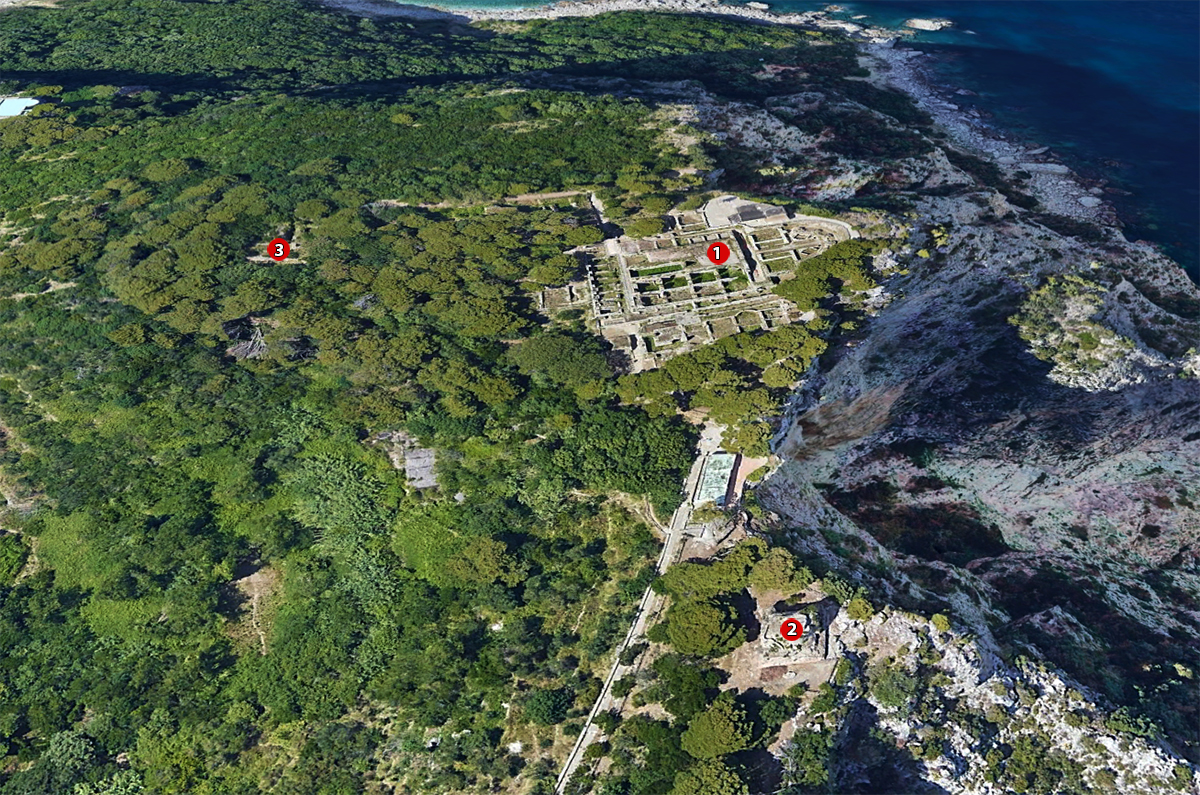
PORTUS COSANUS (Cosa)
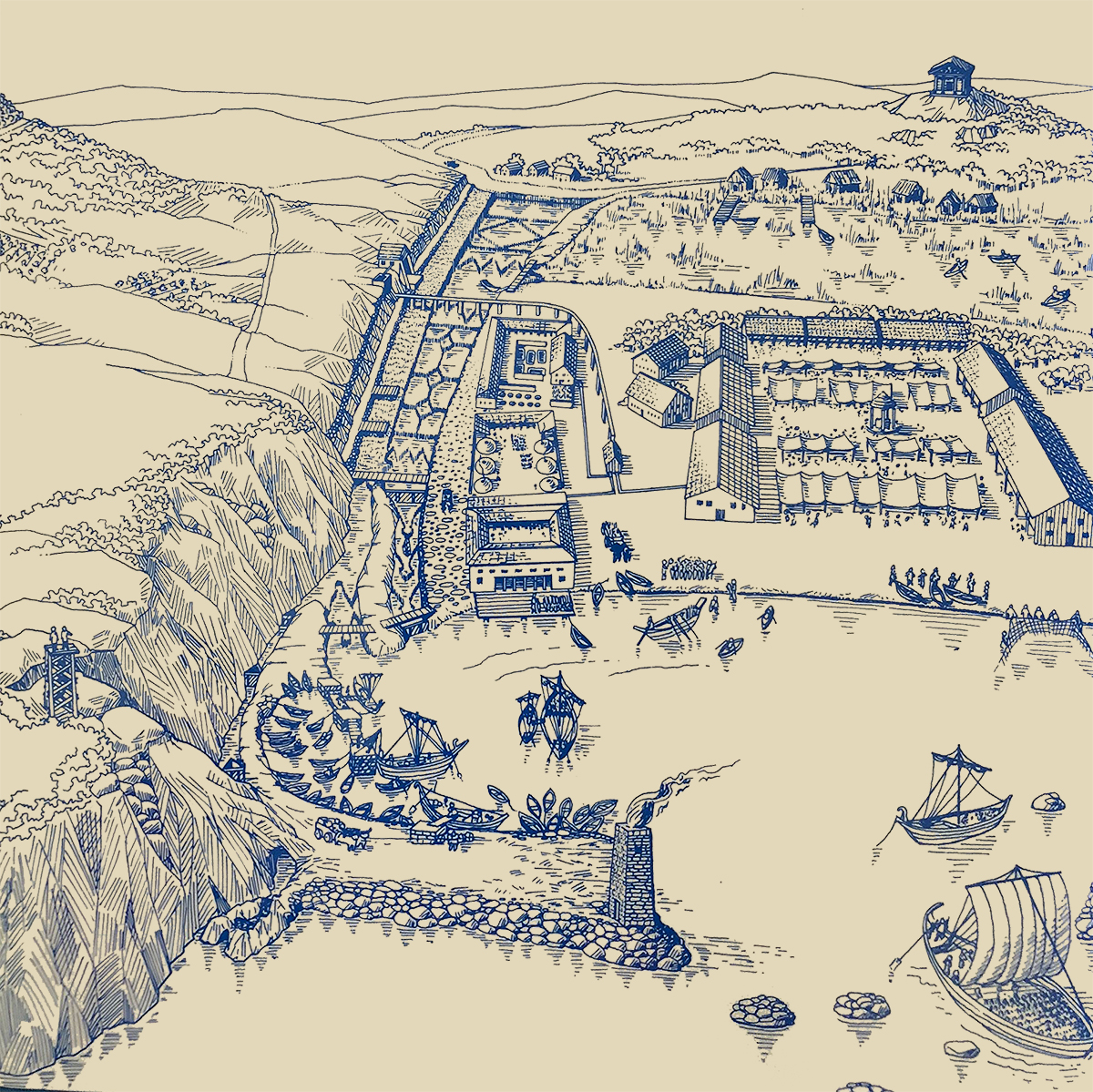
In 273 BC. the Romans founded a military colony in Cosanus to control Etruria. Originally, the favorable geographic position of Cosanus as a port for the military fleet was the main motivation. In that first period, of course, there was no question of a lighthouse because it would also here betray the position of the fleet. But after the military period, the city quickly became a commercial center for the fishing industry where this luxury product was caught, processed and exported to all parts of the empire. It soon became a busy port from which the fish was transported overseas. During this period Portus Cosanus would have needed a lighthouse.
Recent underwater research by the ROMACONS23 archaeological team has made new discoveries about the structures of the harbour, although no definitive evidence of a lighthouse has yet been found. A.M. McCann24 assumed in 1987 that the mole known as No. 5, found close to the confluence of two moles of the inner harbour, was the foundation of a lighthouse25.
In the vicinity of a small temple in this area, a clay tablet depicting a three-storey quadrangular tower with a fire on top was found 26.
Portus Cosanus was in any case the first Roman port built with pozzolan concrete.
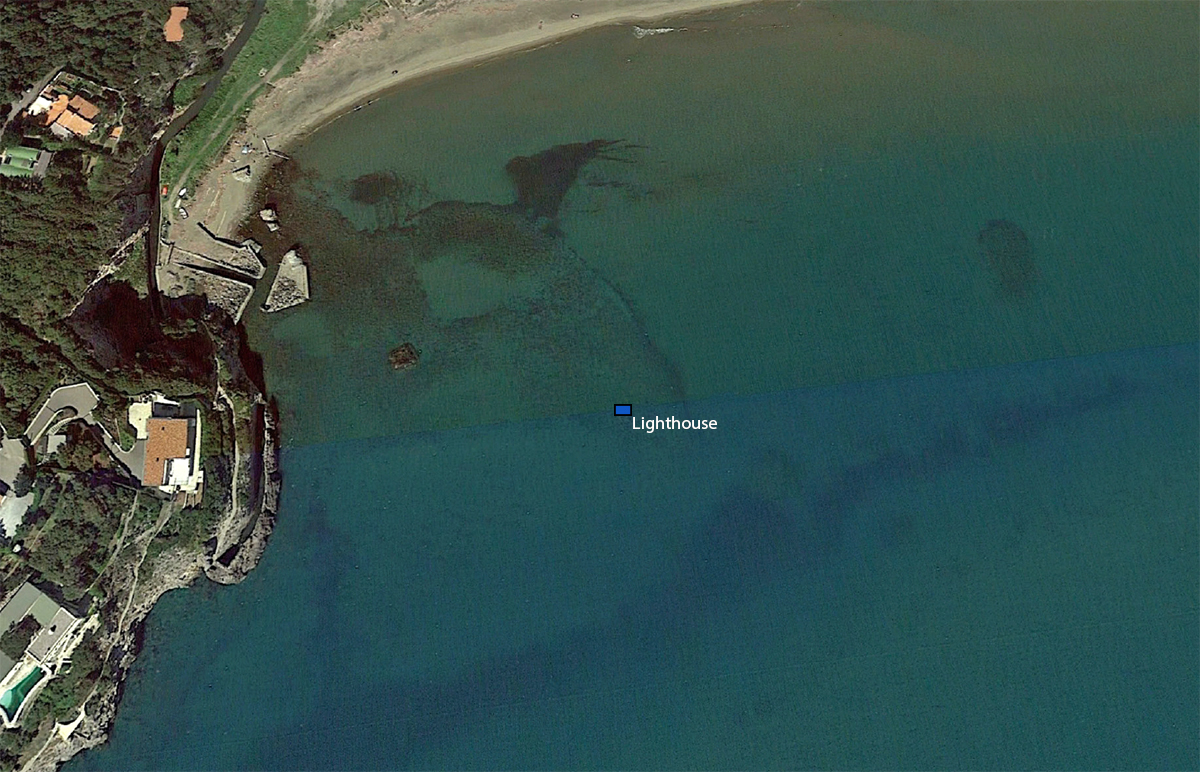
CLASSIS (Ravenna)
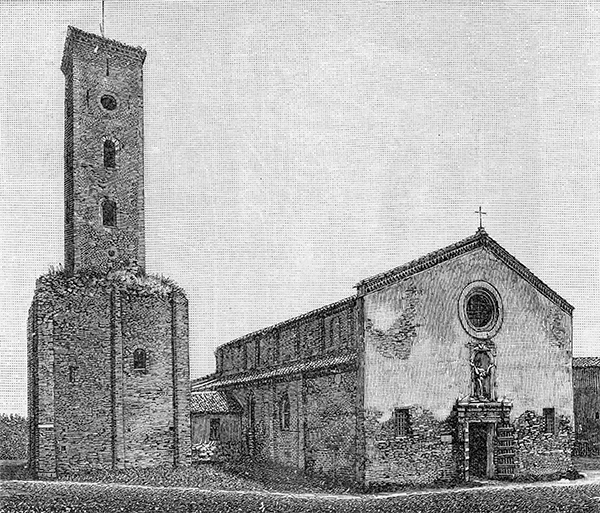
the destruction29.
The port of Ravenna had been bombed by Augustus as a home port for the eastern military fleet. After adjustments by Trajan, the harbour could accommodate at least 250 ships27.
Pliny described the Classis lighthouse as a tower with the structure of the tower of Pharos and thus probably the same design as that of the port of Claudius28.
It is no coincidence that we see a bell tower with the same shape next to the church of Santa Maria in Porto Fuori (Santa Maria in the outer harbour). This tower largely burned down in 1944. In any case, the bottom part of the tower would come from the old Roman lighthouse. The fact that the tower was somewhat removed from the harbour is not seen as a problem because the tower was high enough to allow its light to shine over a great distance30.
THE STRAIT OF MESSINA
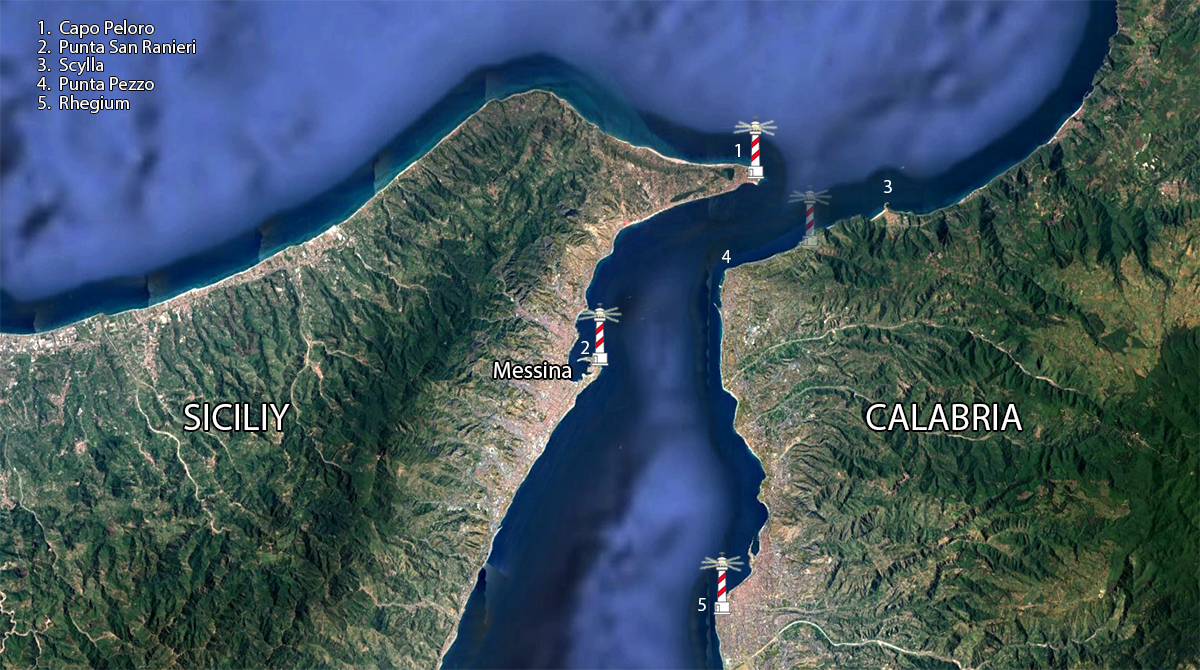
In the past, if one had to sail around the south of Italy, it often went via the water between Sicily and the southernmost tip of the mainland, the Strait of Messina. Recently, on the site of an old fortress called Forte degli Inglese (fortress of the English), a spot, Capo Peloro, has been found where the remains of a Roman lighthouse have been uncovered31. The current lighthouse is about 80 meters from that spot.
The nearest port is in Messina, the Roman Messana, where a sickle-shaped bend formed a natural harbour. At the place where still stands a lighthouse, Punta San Ranieri, undoubtedly there must have been a lighthouse in Roman times as well.
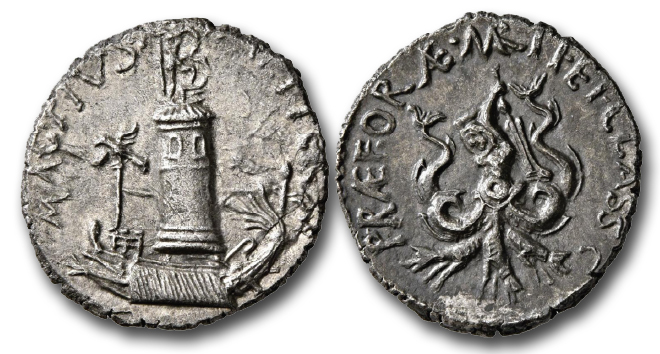
Between 42 and 40 BC. Sextus Pompeius had minted a coin (denarius) showing the lighthouse of Messina on one side and the Scylla monster33 on the reverse.
According to Baldassarre Giardina, Scylla stands for the Strait of Messiana and the lighthouse for the harbour34. There are also other voices saying that this is the lighthouse of Capo Peloro because the area over there is called "Faro".
In a strait like this there must have been several light towers as beacons for navigation on both sides of the passage. One in Capo Peloro and one opposite, on the other coast, somewhere between Scylla and Punto Pezzo.
To get to the port of Messina one had to sail 11-12 km in a straight line. In the harbour itself, people were illuminated by the lighthouse on the Punta San Ranieri.
The at that time most important city in Calabria, the Roman city of Rhegium, is said to have also had a lighthouse. In the last decades no research has been done on this issue and leaves us with the question where it would been located.
NORTH-AFRICA
Many of the Roman ports in North Africa were originally Phoenician ports where light beacons were used, but as mentioned earlier, these were fires from religious elevated places. As far as we known now, the Phoenicians did not build lighthouses.
Roman engineers, on the other hand, were masters of making a standard pattern for harbours; two moles from the coast into the sea creating a safe berth against bad weather; small islands off the coast were included in the plan. Furthermore, there had to be sufficient quays and warehouses to be able to unload or load the ships. Of course that included at least one lighthouse to guide the ships safely to the entrance of the harbour.
We can say with certainty that all the ancient lighthouses found in North Africa were built by the Romans (with the exception of the Alexandrian one). In fact, many, if not all, places where Roman port activities took place were lighthouses. And that started approximately in the first century BC.
CAESAREA MAURETANIA (Cherchell)
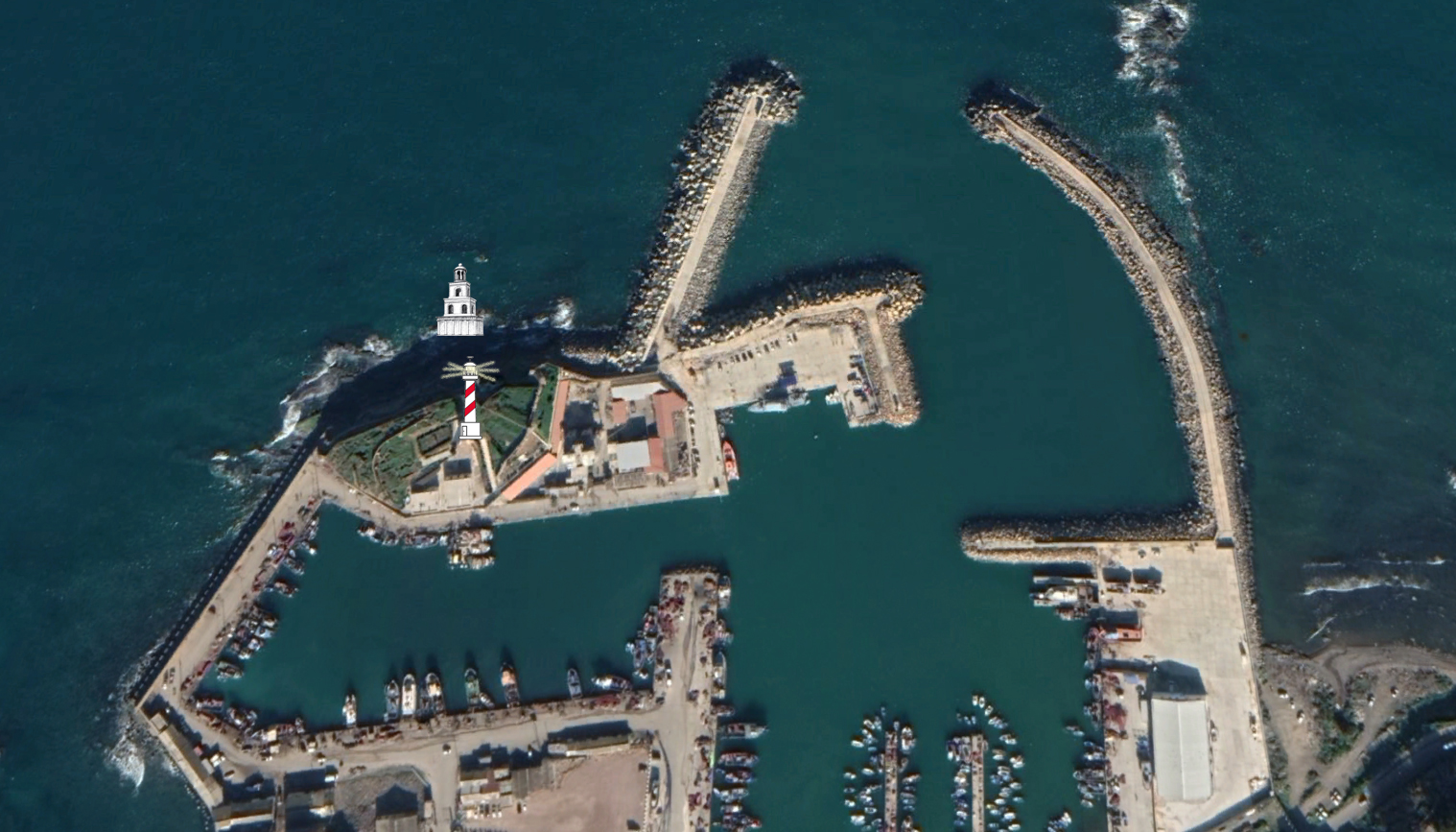
The first lighthouse appeared in this city around the first year BC. It was probably built on an island just off the coast that later became known as Joinville35. Later the island become a part of the mainland to improve the harbour. Unfortunately, little archaeological information about this site is known.
It is possible that the original harbour was slightly to the east of the present small harbour, where a larger rock protruding into the sea provided better protection than an island. Giardina describes two adjacent harbours; a commercial port and a smaller, more protected military port. These two were linked by a channel36.
According to Giardina, the lighthouse was octagonal and consisted of three floors with a cylindrical stone top for the fire37.
APOLLONIA38 and PTOLEMAIS
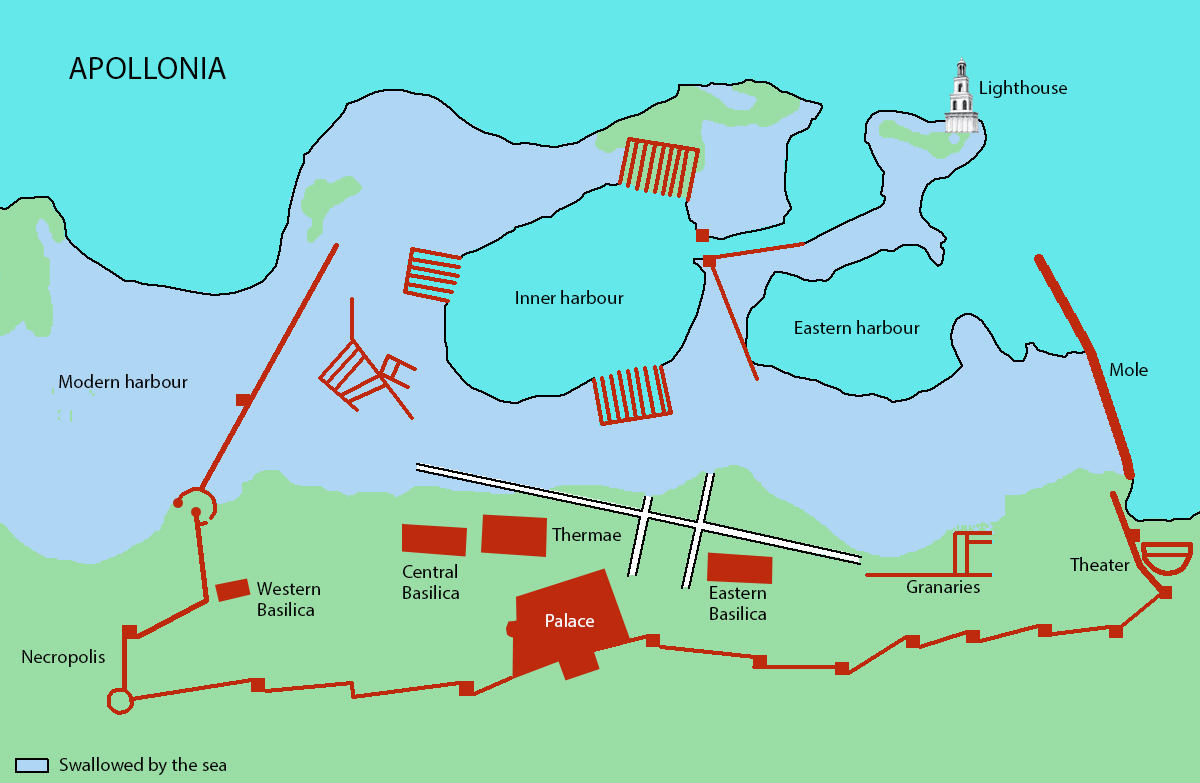
Much of Apollonia's old port is now underwater. However, there is still a small island above the water on which probably a lighthouse stood in ancient times. Satellite images would show a hexagonal or octagonal shape that is interpreted as being the foundation of that lighthouse. In Ptolemais, the old lighthouse has been used as the foundation for the modern lighthouse39.
LEPTIS MAGNA
Around 111 BC. the originally Phoenician city of Leptis Magna came under Roman rule. The city has been part of a large trade network since its foundation.
The emperor Septimus Severus was born in this region and gave in 194 AD. Leptis a special boost that brought, the port in particular, to its peak of activity. In a major redevelopment of the harbour, a large lighthouse also appeared at the far end of the western pier. According to Bartoccini41, the lighthouse would have had three floors and arched windows.
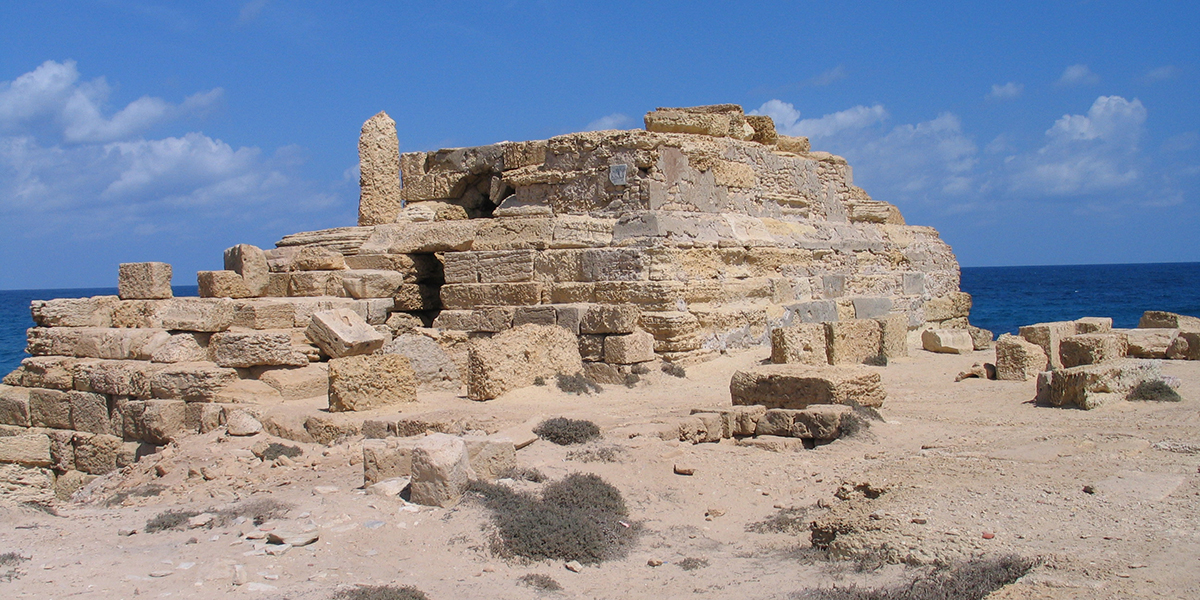
CAESAREA PALESTINA (Sebastos)
The port of Caesarea was built by King Herod near the site of a small Phoenician port. This place was called Stratonos Pyrgos (tower of Stratos), which suggests that there was or had been a lighthouse there at one time43.
This port of Herod, located in Palestine, was dedicated to his "patron", Emperor Augustus, and was named Caesarea Palestine. This is to distinguish, for example, the port of Mauretania, Caesarea Mauretania, dedicated to the emperor.
Not so long ago, extensive underwater research was conducted into the port, which revealed many interesting things. However, the locations of various structures found are still subject to considerable debate, including those of the lighthouse(s).
Flavius Josephus described the harbour when it reached its peak. He spoke about various towers, but unfortunately did not say that those towers had the function of a lighthouse44. It is believed that towers, even those based on the Pharos of Alexandria, were multifunctional and served as food storage, as soldiers' barracks, for communications, as watchtowers, to impress visitors and to aid navigation by producing smoke during the day and Fire in the evening.
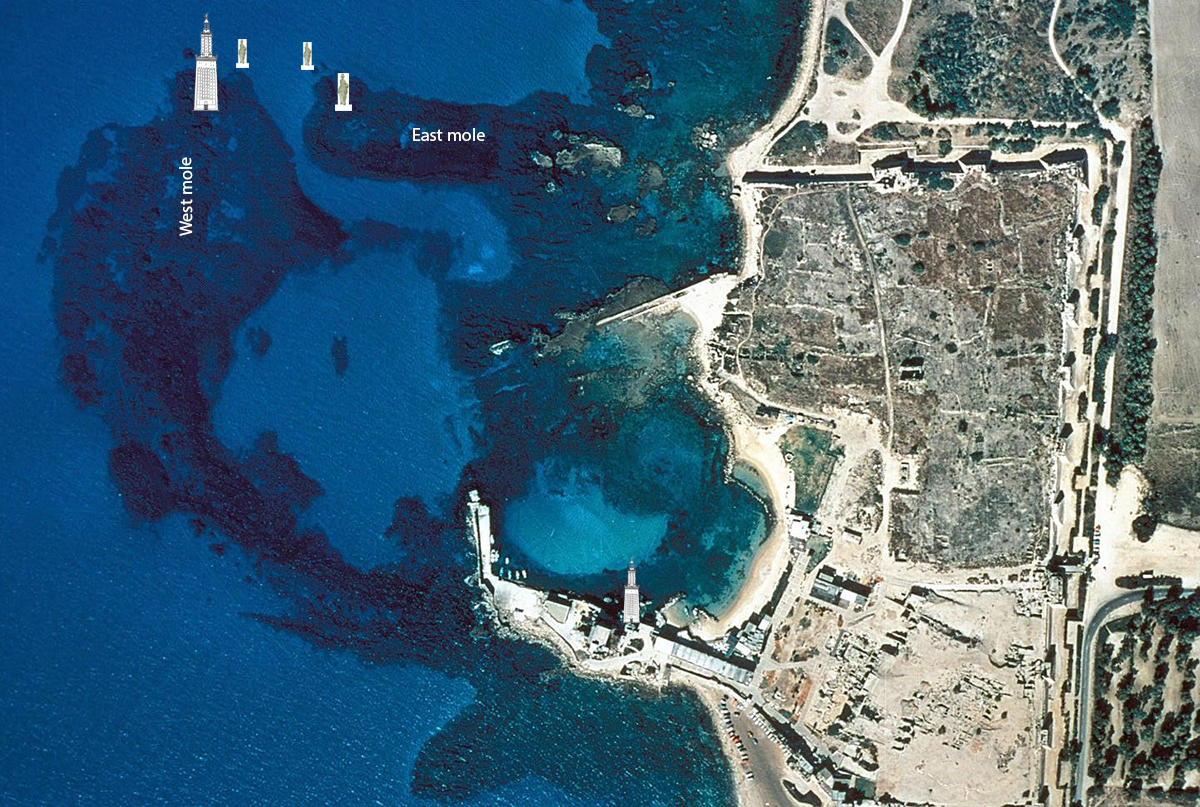
The entrance to the harbour was at the northern side between the east and west mole. Partly on the basis of the rubble found at the base of both moles, it is believed that a tower was built at both ends of the moles standing just outside the entrance. The towers are said to feature images of Meriamme, Herod's favorite wife, and Phasael, his dead brother. Hippicuc, a friend who died in a battle, was honored in a third, larger tower built at the end of the eastern pier.
Finally, on the western mole, where the largest amount of debris lies on the seabed, it is generally assumed that the lighthouse was there. This lighthouse would have the same design as that of the Alexandrian one, but a bit smaller. The tower was known under the name of Drusion Toren. It is said that there was also a lighthouse in the inner harbour, but no evidence of this has yet been found.
FORUM IULII (Fréjus – France)
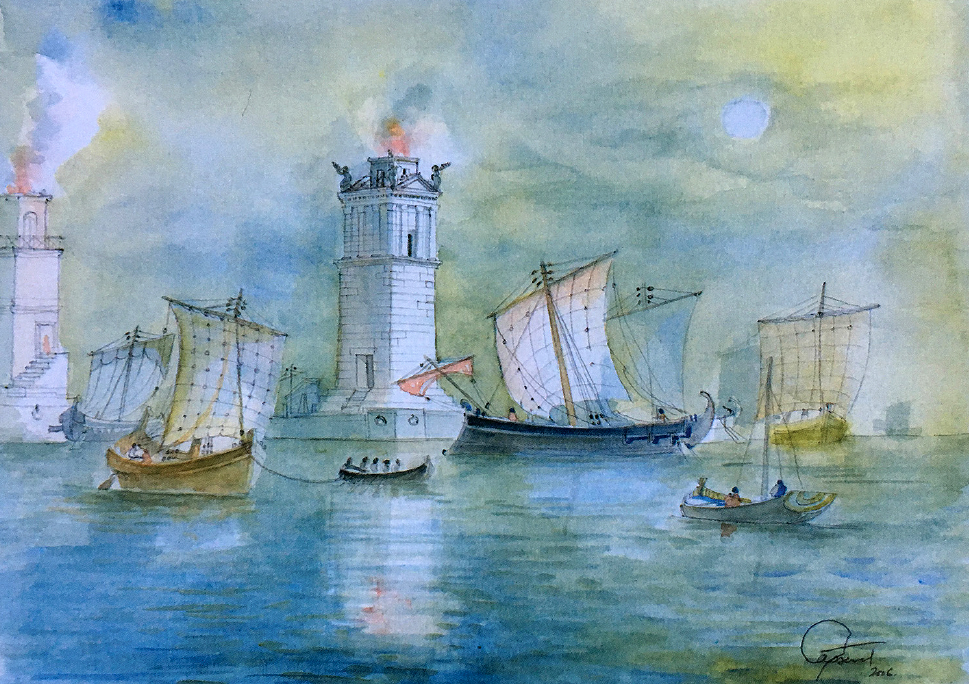
Forum Iulii, along with Massalia (Marseilles), was one of the most important Roman ports in the southern region of the Gallia Narbonesis of that time. Around 49 BC. the city became a province of Rome and was used by Julius Caesar, among other things, to supply his troops in the fight against Pompey.
The emperor Augustus stationed a part of the fleet he had captured at the Battle of Actium, in the harbour of Forum Iulii.
Like so many other old ports, Roman Fréjus is buried under the centuries of siltation. Recent archaeological research has brought up a lot of information about the old port, although many questions remain unanswered46.
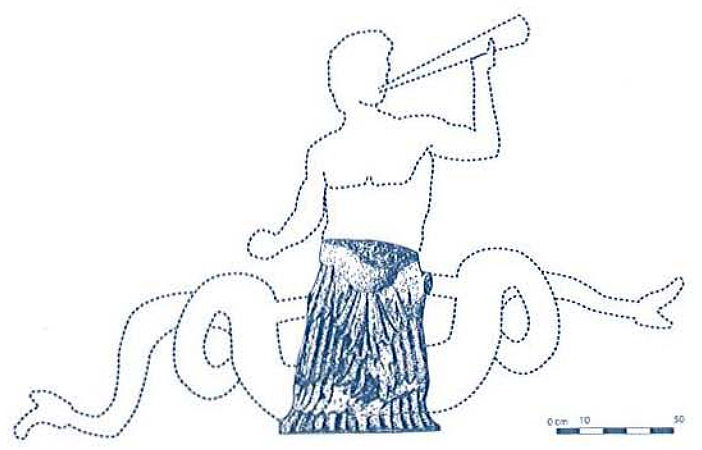
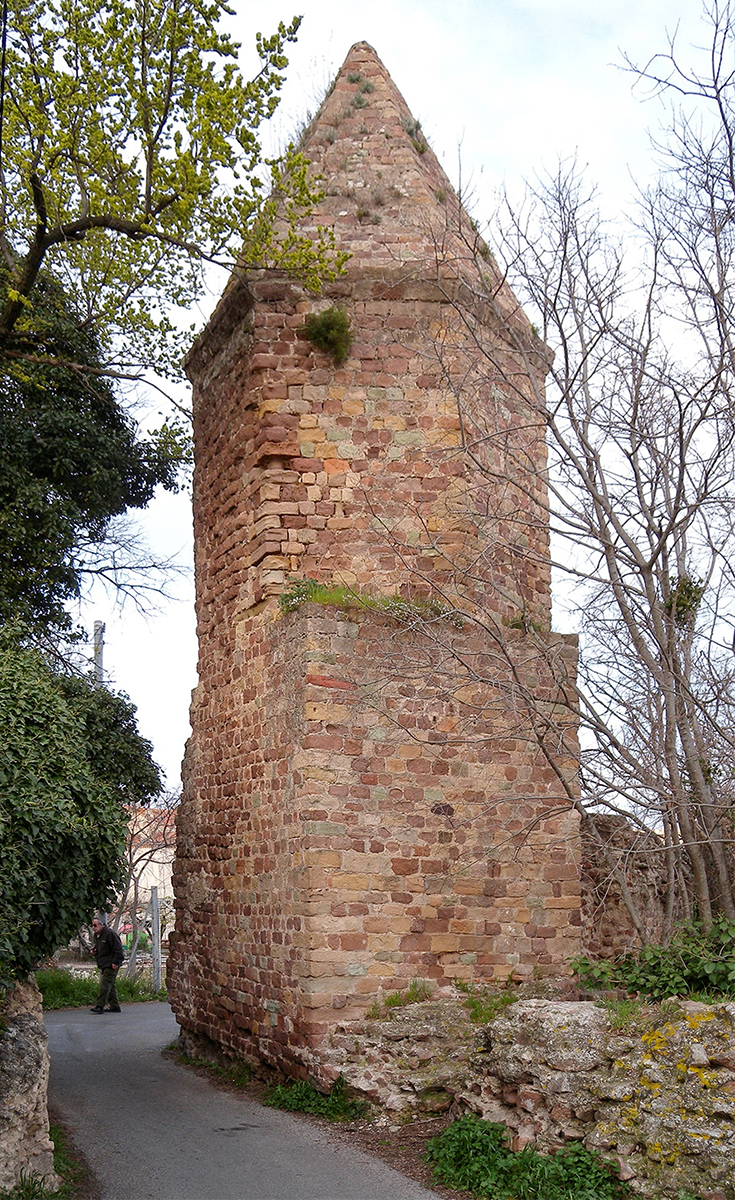
We now know that the harbour was directly on the sea and that people ended up directly on the forum via two quays on the north and south sides of the entrance. As in Leptis Magum and Caesarea Palestine, both quays had a decorative lighthouse. According to an artist impression of the harbour of Forum Iulii (fig. 22), the lighthouse was equipped with Tritons47 at the corners of the top as was the Pharos of Alexandria.
A statue of a Triton has indeed been found in the entrance to the harbour. This statue and the remains of a Roman structure discovered near the end of the north quay has been considered as a lighthouse at the far end of the north pier.
About 100 meters south of this, the researchers designated a place where a second similar tower would have stood. This place is close to the modern Lanterne d'Auguste, which, contrary to what has been claimed, can never have been a lighthouse.
It is assumed that there was a third lighthouse on the Ile du Lion de Mer. This would have been a round tower with a diameter of 9.5 meters and the first beacon seen when approaching Portus Iulii.
MASSALIA (Marseilles)
Although some writers49 ascribe to Massalia a lighthouse on the Tête de More, a hill overlooking the entrance to the harbour, no evidence of a lighthouse has ever been found. After extensive archaeological research, a good idea has been formed about the layout of the old port itself.
On a map of Marseille from 1572 we see the old port with a number of possible locations for a lighthouse. It is almost certain that there was a lighthouse, but we simply do not have any proof for this (yet). This is of course true for many other ports and just shows that there is still much work to be done by archaeologists.
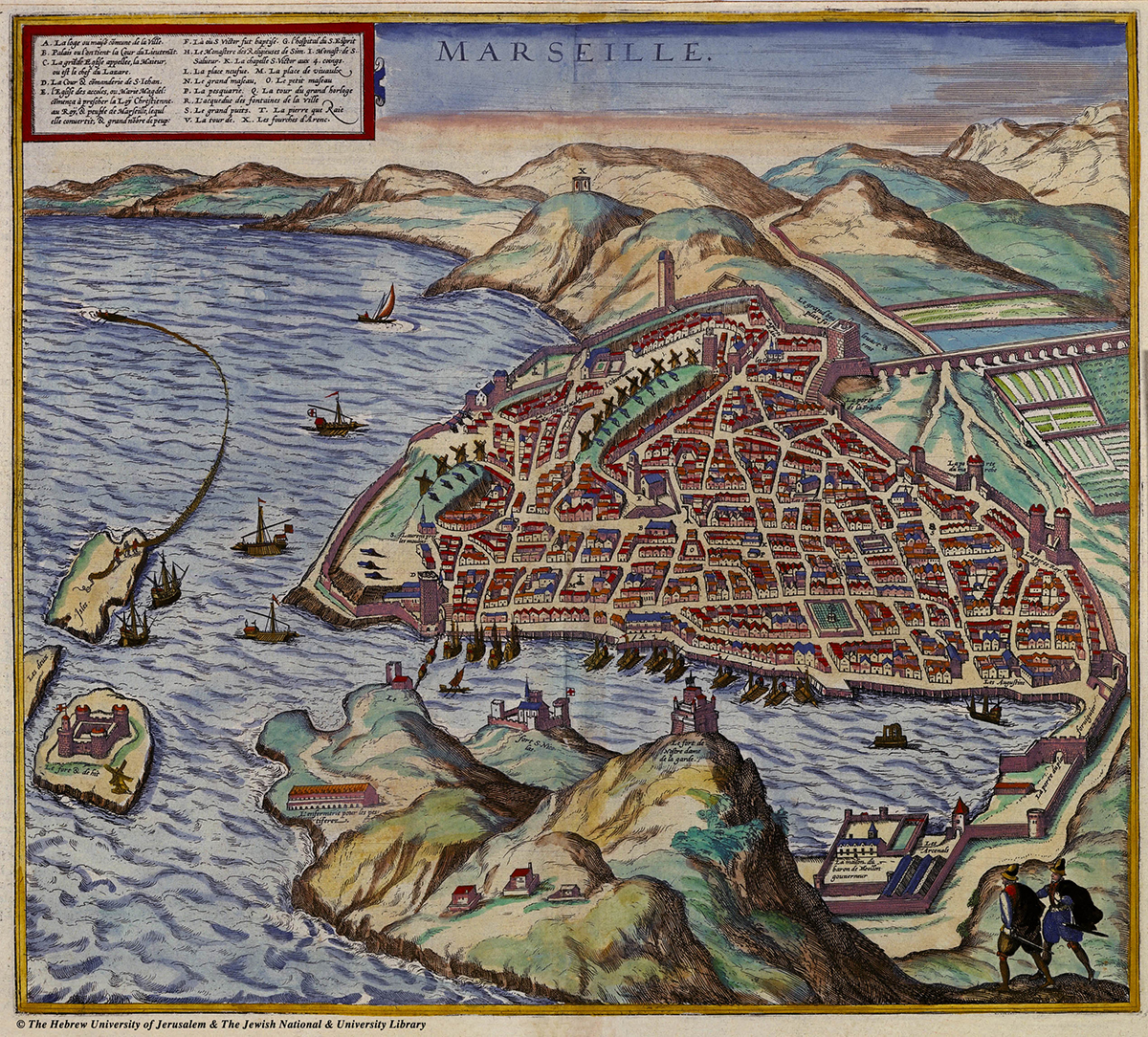
- Sources
- - Ancient Lighthouses - Part 6: Lighthouses After The Pharosby Ken Trethewey
Notes- 1: Ken Trethewey is a retired marine engineer specialising in corrosion and materials engineering. He currently works as a pharologist. Based in Cornwall UK.
- 2: Casson, Lionel: The Ancient Mariners - Seafarers and Sea Fighters of the Mediterranean in Ancient Times. Princeton University Press, 2nd edition (1991).
- 3: Read article: 'A harbour for Rome'
- 4: R. Meiggs, Roman Ostia; 115.
- 5: Photo Wikimedia-MM
- 6: Suetonius: Claudius XX – translation: “He formed the harbour of Ostia by building circular moles on the right and left, with a breakwater that protects the entrance to the harbour in deep water. To secure the foundation of this breakwater, he sank the ship on which the great obelisk had been brought from Egypt; and built a very high tower on stilts, in imitation of the lighthouse in Alexandria, on which lights were lit at night to guide sailors. "
- 7:Read article:'Warehouse of the world'
- 8: The port was completed by Claudius's successor, the Emperor Nero, in AD 64.
- 9: Read article:'Marble for Rome'
- 10: Zemke (1992), Vol. 1, p6.
- 11: Giardina, Baldassarre; Navigare Necesse Est – Lighthouses from Antiquity to the Middle Ages; History, Architecture, Iconography and Archaeological Remains - (2010) p103.
- 12: Read article:'Centumcellae, the port of Trajan'.
- 13: Anxur was the name the original inhabitants gave to the city
- 14: Read article:'Tarracina the fourth harbour of Trajan'
- 15: Read article:'Campi Flegrei'.
- 16: Oleson, J. P. and M. D. Jackson: The Technology of Roman Maritime Concrete (2014b), pp1-10.
- 17:Bodleian Library, University of Oxford; Arch. Antiq. B subt. 18, pl. XIII.
- 18:Giardina, Baldassarre; Navigare Necesse Est – Lighthouses from Antiquity to the Middle Ages; History, Architecture, Iconography and Archaeological Remains. – (2010) p295.
- 19:Photo: Roberto De Martino (2008); now in the Public Domain.
- 20:Krause, Clemens: Villa Jovis. Die Residenz des Tiberius auf Capri, Verlag Philipp von Zabern, Mainz am Rheim (2003)
- 21: Suetonius: Augustus 49
- 22: Cover "The Roman Port and Fishery of Cosa" by Anna Marquerite McCann. Drawing Kathleen K. Borowick.
- 23: ROMACONS (Roman Maritime Concrete Studies) organization that conducts underwater archaeological research into Roman concrete structures.
- 24: American art historian and archaeologist and the first American woman in the field of underwater archeology (1933 - 2017)
- 25: Anna Marguerite McCann: The Roman port and fishery of Cosa.
- 26: Giardina (2010), p107.
- 27: Read article:'Roman Military harbours'
- 28: Pliny the Elder: The Natural History 36 -The Natural History Of Stones, Chapter 18: The Pharos.
- 29: Photo Wikipedia - Giuseppe Barberis.
- 30: Hutton, Edward: Ravenna - A Study (1913).
- 31: Buceti, Giuseppe: Gialo. I Misteri Del Peloro, Messina, EDAS (2012).
- 32: Sextus Pompeius Magnus Pius, Roman general (ca 68 BC - 35 BC).
- 33:Sea monster from Greek mythology.
- 34:Giardina (2010), p93.
- 35: Robert L. Hohfelder, Christopher Brandon and John P. Oleson : Constructing the Harbour of Caesarea on the Sea: New Evidence from the ROMACONS Field Campaign of October 2005.
- 36: Giardina (2010), p 51.
- 37: Giardina (2010), p 230.
- 38: Read article:'Apollonia, the harbour of the African Athens'.
- 39: Read article:'Ptolemais, the homeland of Arius and his polemical Christianity'.
- 40: Read article:'Leptis Magna, main gate to Africa'.
- 41: Renato Bartoccini: Il Porto Romano di Leptis Magna, In Bollettino del Centro Studi sull’ Architetturo, Supplemento 13, Roma (1958).
- 42: Photo: Roger Pearse (2011).
- 43: Read article:'A jewish port for the emperor'.
- 44: Titus Flavius Josephus (Roman Jewish historian (Jerusalem, 37 AD - Rome, 100AD)), Jewish Antiquities XV, 22.
- 45: Photo: J-M Gassend (2006) in Gébara (2010).
- 46: Gébara, Chérine; Christophe Morhange: Fréjus (Forum Julii); Le Port Antique; The Ancient Harbour. Portsmouth, R.I., Journal of Roman Archaeology (2010).
- 47: Neptune's companions - half human, half sea creature.
- 48: Photo: Michel Royon / Wikimedia Commons.
- 49: Allard, Emile: Les Phares. Histoire, construction, éclairage, Paris (1889), p25.
- 50: Marseille, 1572, Braun and Hogenberg, Map II-12, Civitates Orbis Terrarum. Courtesy of Historic Cities Research Project, The Hebrew University of Jerusalem and the Jewish National and Jewish University.






 We are committed to providing versions of our articles and interviews in several languages, but our first language is English.
We are committed to providing versions of our articles and interviews in several languages, but our first language is English.